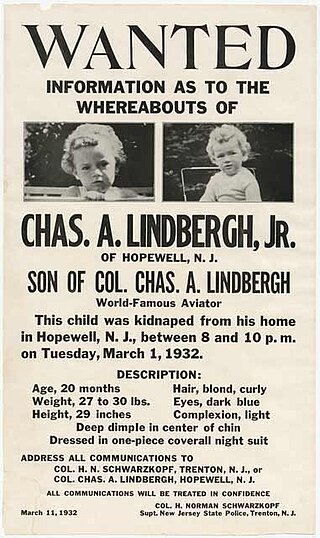Related Research Articles

The Federal Bureau of Investigation (FBI) is the domestic intelligence and security service of the United States and its principal federal law enforcement agency. Operating under the jurisdiction of the United States Department of Justice, the FBI is also a member of the U.S. Intelligence Community and reports to both the Attorney General and the Director of National Intelligence. A leading U.S. counterterrorism, counterintelligence, and criminal investigative organization, the FBI has jurisdiction over violations of more than 200 categories of federal crimes.

The Oklahoma City bombing was a domestic terrorist truck bombing of the Alfred P. Murrah Federal Building in Oklahoma City, Oklahoma, United States, on April 19, 1995, the second anniversary of the fiery end to the Waco siege. It was the deadliest act of terrorism in U.S. history until the September 11 attacks in 2001, and remains the deadliest act of domestic terrorism in U.S. history, and the second-deadliest overall.

Forensic science, also known as criminalistics, is the application of science to criminal and civil laws. During criminal investigation in particular, it is governed by the legal standards of admissible evidence and criminal procedure. It is a broad field utilizing numerous practices such as the analysis of DNA, fingerprints, bloodstain patterns, firearms, ballistics, and toxicology.

Bruno Richard Hauptmann was a German-born carpenter who was convicted of the abduction and murder of the 20-month-old son of aviator Charles Lindbergh and his wife Anne Morrow Lindbergh. The Lindbergh kidnapping became known as "The Crime of the Century". Both Hauptmann and his wife, Anna Hauptmann, proclaimed his innocence to his death, when he was executed in 1936 by electric chair at the Trenton State Prison.

On March 1, 1932, Charles Augustus Lindbergh Jr., the 20-month-old son of aviators Charles Lindbergh and Anne Morrow Lindbergh, was abducted from his crib in the upper floor of the Lindberghs' home, Highfields, in East Amwell, New Jersey, United States. On May 12, the child's corpse was discovered by a truck driver by the side of a nearby road.

The Waco siege, also known as the Waco massacre, was the siege by U.S. federal government and Texas state law enforcement officials of a compound belonging to the religious cult known as the Branch Davidians between February 28 and April 19, 1993. The Branch Davidians, led by David Koresh, were headquartered at Mount Carmel Center ranch in the community of Axtell, Texas, 13 miles northeast of Waco. Suspecting the group of stockpiling illegal weapons, the Bureau of Alcohol, Tobacco, and Firearms (ATF) obtained a search warrant for the compound and arrest warrants for Koresh and several of the group's members.
The National Center for the Analysis of Violent Crime (NCAVC) is a specialist FBI department. The NCAVC's role is to coordinate investigative and operational support functions, criminological research, and training in order to provide assistance to federal, state, local, and foreign law enforcement agencies investigating unusual or repetitive violent crimes.
The Behavioral Analysis Unit (BAU) is a department of the Federal Bureau of Investigation's National Center for the Analysis of Violent Crime (NCAVC) that uses behavioral analysts to assist in criminal investigations. The mission of the NCAVC and the BAU is to provide behavioral based investigative and/or operational support by applying case experience, research, and training to complex and time-sensitive crimes, typically involving acts or threats of violence.

Robert K. Ressler was an FBI agent and author. He played a significant role in the psychological profiling of violent offenders in the 1970s and is often credited with coining the term "serial killer", though the term is a direct translation of the German term "Serienmörder" coined in 1930 by Berlin investigator Ernst Gennat. After retiring from the FBI, he authored a number of books on serial murders, and often gave lectures on criminology.

Offender profiling, also known as criminal profiling, is an investigative strategy used by law enforcement agencies to identify likely suspects and has been used by investigators to link cases that may have been committed by the same perpetrator. Multiple crimes may be linked to a specific offender and the profile may be used to predict the identified offender's future actions.

John Edward Douglas is an American retired special agent and unit chief in the United States Federal Bureau of Investigation (FBI). He was one of the first criminal profilers and has written and co-written books on criminal psychology, true crime novels, and his biography.

The FBI Laboratory is a division within the United States Federal Bureau of Investigation that provides forensic analysis support services to the FBI, as well as to state and local law enforcement agencies free of charge. The lab is located at Marine Corps Base Quantico in Quantico, Virginia. Opened November 24, 1932, the lab was first known as the Technical Laboratory. It became a separate division when the Bureau of Investigation (BOI) was renamed as the FBI.

The Behavioral Science Unit (BSU) is the original name of a unit within the Federal Bureau of Investigation's (FBI) Training Division at Quantico, Virginia, formed in response to the rise of sexual assault and homicide in the 1970s. The unit was usurped by the Critical Incident Response Group (CIRG) and renamed the Behavioral Research and Instruction Unit (BRIU) and currently is called the Behavioral Analysis Unit (5) (BAU-5) within the National Center for Analysis of Violent Crime (NCAVC). The BAU-5 currently works on developing research and then using the evidence-based results to provide training and improve consultation in the behavioral sciences—understanding who criminals are, how they think, why they do what they do—for the FBI and law enforcement communities.

Theodore L. Gunderson was a Federal Bureau of Investigation Special Agent In Charge, head of the Los Angeles FBI, and an American author. Some of his FBI case work included the Death of Marilyn Monroe and the Assassination of John F. Kennedy. He was the author of the best-selling book How to Locate Anyone Anywhere Without Leaving Home. In later life, he researched a number of topics, notably including satanic ritual abuse.
McCrary is a surname. It is derived from the Scottish Gaelic surname Mac Ruidhrí.

David J. Icove is a former Federal Bureau of Investigation Criminal Profiler and FBI Academy Instructor in the elite Behavioral Analysis Unit. He was one of the FBI's first criminal profilers to specialize in the apprehension of serial arsonists and bombers. He is Fellow in the National Academy of Forensic Engineers and co-author along with Gerald A. Haynes of Kirk's Fire Investigation, the leading textbook in the field of fire investigation.
Justin Tanner Petersen was an American hacker, concert promoter, sound engineer, private investigator and an informant for the Federal Bureau of Investigation. While tasked with helping to catch other hackers and fugitives wanted by the FBI, he continued to commit serious crimes.
Jens Söring, usually rendered in English as Jens Soering, is a German who, in 1990, was convicted in Virginia, United States of America of murdering the parents of his then-girlfriend, Elizabeth Haysom. For her role in the deaths, Haysom was convicted of two counts of accessory before the fact to murder.
James R. Fitzgerald is an American criminal profiler, forensic linguist, and author. He is a retired FBI agent and best known for his role in the UNABOM investigation, which resulted in the arrest and conviction of Ted Kaczynski.

Mindhunter: Inside the FBI's Elite Serial Crime Unit is a 1995 non-fiction crime book written by retired FBI agent John E. Douglas and his co-author Mark Olshaker.
References
- ↑ "Home". behavioralcriminology.com.
- 1 2 3 "Gregg O. McCrary". Behavioral Criminology International. Archived from the original on 10 April 2013. Retrieved 20 November 2010.
- ↑ Wright, Stuart A. (1995). Armageddon in Waco: critical perspectives on the Branch Davidian conflict . University of Chicago Press. p. 290. ISBN 978-0-226-90845-8.
- ↑ Ebisike, Norbert (October 2008). Offender profiling in the courtroom: the use and abuse of expert witness testimony. Greenwood Publishing Group. p. 94. ISBN 978-0-313-36210-1.